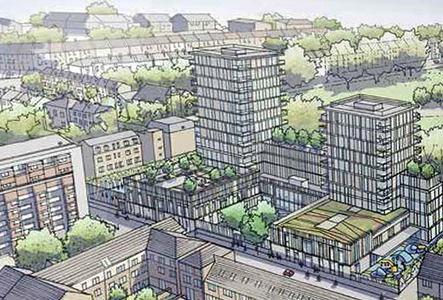1,000 signatures reached
To: Ian Hodges and Anne Canning, Hackney Learning Trust; Vincent Stops, Hackney Council; John Allen, Assistant Director, Planning and Regulatory Services; Diane Abbott, MP Hackney; Jules Pipe, Mayor of Hackney; Boris Johnson, Mayor of London
Hackney school playgrounds are not for sale

Stop Hackney from demolishing our schools and selling off the playgrounds to build luxury flats.
The new schools will have twice as many students crammed in, no green space, and be built in the shadow of high-rise luxury residental towers.
We want to stop them from selling off this public land asset, and make sure the children of Benthal and Nightingale primary schools have great schools to learn and grow in.
The new schools will have twice as many students crammed in, no green space, and be built in the shadow of high-rise luxury residental towers.
We want to stop them from selling off this public land asset, and make sure the children of Benthal and Nightingale primary schools have great schools to learn and grow in.
Why is this important?
Hackney has its eyes on growing land values in this fast gentrifying London borough. It plans to demolish three primary schools and carve up the plots, building private homes for sale on designated education land - selling off the playgrounds and digging up the trees to build luxury flats.
The new schools will be rebuilt on a fraction of the original sites, some with twice as many pupils squeezed in. The number of private luxury flats crammed in doesn’t leave room for much else. At the first proposed school, the play spaces are on the roof, in permanent shadow of the towers. The residents will be able to look right down on top of the school. As for the classrooms, there aren’t many windows. The corridors are internal, artificially lit rat-runs.
The first proposed school is opposite a park, but south-facing, high-rise residential towers will block all the natural daylight. Ironically, residential towers on this site were demolished 20 years ago as a sign of progress.
My son’s current school, Nightingale Primary, is not perfect. But it has dignity as a school, and room to play: There’s a grassy hill with enough bushes and trees for a game of hide and seek, plus a bee hive, kitchen garden, football pitch and three surfaced play areas, one for nursery, one for reception and one for everyone else.
All of this will be sold off to build flats that likely will be sold for 'investment' - it may be that no one actually even lives there.
Children spend 30 per cent of their life in school, with profound effects on their health and development. A 2007 Danish study showed that fresh air ventilation rates are linked to pupil performance. In a study of 2,111 Spanish schoolchildren, time spent in (not near) green spaces reduced behavioural and emotional problems, reducing hyperactivity and improving ADHD scores. A six-year American study on 905 Massachusetts elementary schools found pupils in schools with more ‘greenness’ scored higher in standardised tests. Chinese scientists discovered a 23 per cent reduction in shortsightedness among children who spend an additional 40 minutes in the sun.
In a wealthy city such as London, there is no excuse for such poor stewardship of a land asset that, once sold, will be gone forever. With the shortage of school places, we will need education land to build on. We once battery-farmed hens until it was found to be too cruel. Are we going to battery-farm our children?
Please help us stop the Hackney Learning Trust.
The new schools will be rebuilt on a fraction of the original sites, some with twice as many pupils squeezed in. The number of private luxury flats crammed in doesn’t leave room for much else. At the first proposed school, the play spaces are on the roof, in permanent shadow of the towers. The residents will be able to look right down on top of the school. As for the classrooms, there aren’t many windows. The corridors are internal, artificially lit rat-runs.
The first proposed school is opposite a park, but south-facing, high-rise residential towers will block all the natural daylight. Ironically, residential towers on this site were demolished 20 years ago as a sign of progress.
My son’s current school, Nightingale Primary, is not perfect. But it has dignity as a school, and room to play: There’s a grassy hill with enough bushes and trees for a game of hide and seek, plus a bee hive, kitchen garden, football pitch and three surfaced play areas, one for nursery, one for reception and one for everyone else.
All of this will be sold off to build flats that likely will be sold for 'investment' - it may be that no one actually even lives there.
Children spend 30 per cent of their life in school, with profound effects on their health and development. A 2007 Danish study showed that fresh air ventilation rates are linked to pupil performance. In a study of 2,111 Spanish schoolchildren, time spent in (not near) green spaces reduced behavioural and emotional problems, reducing hyperactivity and improving ADHD scores. A six-year American study on 905 Massachusetts elementary schools found pupils in schools with more ‘greenness’ scored higher in standardised tests. Chinese scientists discovered a 23 per cent reduction in shortsightedness among children who spend an additional 40 minutes in the sun.
In a wealthy city such as London, there is no excuse for such poor stewardship of a land asset that, once sold, will be gone forever. With the shortage of school places, we will need education land to build on. We once battery-farmed hens until it was found to be too cruel. Are we going to battery-farm our children?
Please help us stop the Hackney Learning Trust.
How it will be delivered
Email the signatures to Ian Hodges, The Learning Trust

